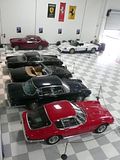
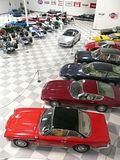
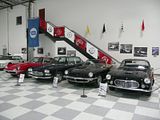 I have Dan to thank for alerting me to the existence of this museum. He’s not been to Southern California, and I have made numerous trips there in the past few years, so it may seem a little odd that I was blissfully ignorant of this collection, while he seemed to know more about it. In my defence, it turns out that the museum did only open a couple of years ago, and now I have been, I have to say that you need to be very determined to find it. There are no signs at all, and even when I was within a few feet of the place, I was about to give up all hope. Housed in a new, purpose built warehouse type facility, it is on a campus at the end of long street that just stops as it reaches the foothills of the mountains, in the outskirts of Riverside, a Southern Californian town about half way between Los Angeles and Palm Springs. I do not accept defeat easily, though, so when I found 829 Marlborough Avenue, I knew that 815, location of the museum, should be close. I drove into a business unit, and then found one small sign pointing me onwards to the target. I have to say that it was well worth the trip.
I have Dan to thank for alerting me to the existence of this museum. He’s not been to Southern California, and I have made numerous trips there in the past few years, so it may seem a little odd that I was blissfully ignorant of this collection, while he seemed to know more about it. In my defence, it turns out that the museum did only open a couple of years ago, and now I have been, I have to say that you need to be very determined to find it. There are no signs at all, and even when I was within a few feet of the place, I was about to give up all hope. Housed in a new, purpose built warehouse type facility, it is on a campus at the end of long street that just stops as it reaches the foothills of the mountains, in the outskirts of Riverside, a Southern Californian town about half way between Los Angeles and Palm Springs. I do not accept defeat easily, though, so when I found 829 Marlborough Avenue, I knew that 815, location of the museum, should be close. I drove into a business unit, and then found one small sign pointing me onwards to the target. I have to say that it was well worth the trip.There are two principal themes to the museum: racing cars, primarily Eagle Indy cars from the 1960s til their last car from around the turn of the century, and Maserati. The museum does its own repair and restoration work, and tries to keep all the cars in running order. Many of them have indeed been regularly taken out for exercise.
From 1957 until 1988, Riverside was home to an international race track, but since then it has sadly been dismantled and the land redeveloped. The museum guide, to whom I spoke for probably best part of an hour, had worked there for most of his professional career, fulfilling a variety of roles in the Press Office and at the circuit. He had also enjoyed an amateur motor sport career, racing a Morgan, and had owned a TR3 and a Daimler SP250 (Dart) – which he said tended to blow a water pump every race. He had lots of tales to tell, and also told me how at the end of March the museum had convened a weekend for as many famous drivers from the 1960s to the present day – Shelby, Penske, Denny Hulme, Dan Gurney etc who had regaled everyone with all sorts of tall tales from their days competing, and many historic film clips were shown. The event will be repeated 26 – 28 March 2010 and sounds like fun if anyone happens to be in the area. Believe it or not, once there was a Formula 1 race staged at Riverside.
Highlight of the racing car section is a series of Eagle Indy cars, ranging from the earliest 1966 model, all the way to the last cars from the very late 1990s, and which illustrate graphically how the race car changed during this time.
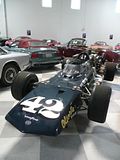
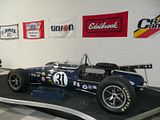
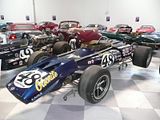
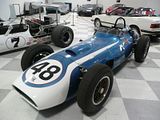
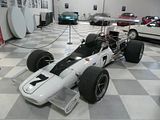
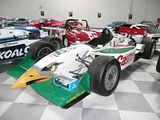
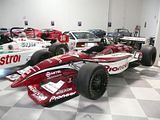

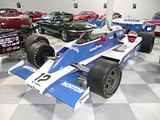 This Scarab is absolutely unique. It competed – not very successfully – in Formula 1 in 1967, and is unusual in that it is front engined. Based on an Indy car design, the driver sits to one side of the body, so that the gearbox and transmission can pass to the rear, The car has even been seen in the UK, making an appearance at the Goodwood Festival of Speed in 2001.
This Scarab is absolutely unique. It competed – not very successfully – in Formula 1 in 1967, and is unusual in that it is front engined. Based on an Indy car design, the driver sits to one side of the body, so that the gearbox and transmission can pass to the rear, The car has even been seen in the UK, making an appearance at the Goodwood Festival of Speed in 2001.  There are a few other cars with a racing pedigree included within the collection.
There are a few other cars with a racing pedigree included within the collection.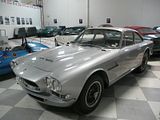
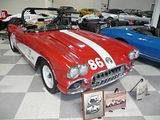
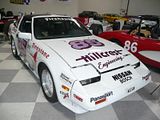
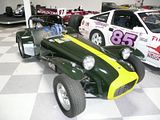 The museum has to have one of the best collections of Maserati anywhere in the world, with just about all road car models represented.
The museum has to have one of the best collections of Maserati anywhere in the world, with just about all road car models represented.A 1951 AG6, this very rare car is only the second road car type built by Maserati. It was styled by Pininfarina, something which did not happen again until the 2003 Quattroporte, as there were strong objections from rival brand Ferrari, who managed to preclude Farina styling cars for Maserati for 50 years
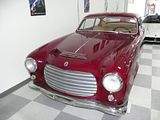
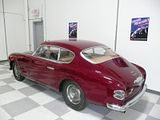
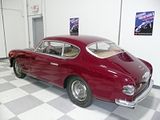 The 3500GT, launched in 1959 was a truly splendid grand tourer and set the tome for Maserati for the decades to come.
The 3500GT, launched in 1959 was a truly splendid grand tourer and set the tome for Maserati for the decades to come.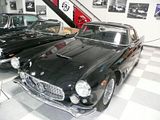
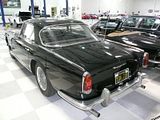
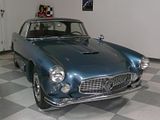
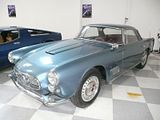 The 1963 Quattroporte was something quite special when first announced, as it was effectively a four door, four seater sports car
The 1963 Quattroporte was something quite special when first announced, as it was effectively a four door, four seater sports car
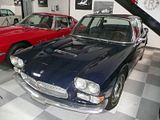 The Mistral, launched in 1964, was the first of many Maserati cars to be named after a wind. Styled by Frua, this gorgeous coupe was essentially no more than an update of the 3500 GT, with a body styled by Frua, based on a shorter wheelbase. A convertible was added to the range, but sold in small numbers.
The Mistral, launched in 1964, was the first of many Maserati cars to be named after a wind. Styled by Frua, this gorgeous coupe was essentially no more than an update of the 3500 GT, with a body styled by Frua, based on a shorter wheelbase. A convertible was added to the range, but sold in small numbers.

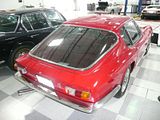
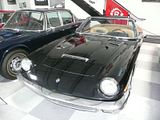
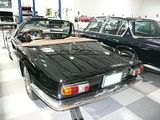 The Sebring, an updated version of the 3500GT, and named after the famous Florida racetrack.
The Sebring, an updated version of the 3500GT, and named after the famous Florida racetrack.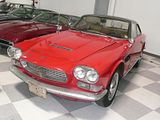 The Mexico, dating from 1968.
The Mexico, dating from 1968.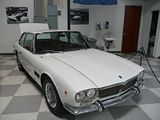 The Ghibli
The Ghibli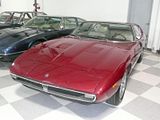
 The Indy
The Indy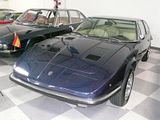 This 1971 Quattroporte II is rather special, as it is one of just two such prototypes, built by Frua for the King Juan Carlos of Spain.
This 1971 Quattroporte II is rather special, as it is one of just two such prototypes, built by Frua for the King Juan Carlos of Spain.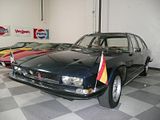
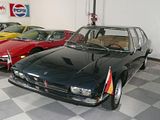
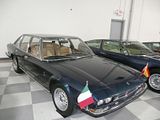 The Bora: almost as fast as the Countach and Ferrari 365BB, this car never attracted the same level of interest when it was new, which is a shame. I think these cars are stunning.
The Bora: almost as fast as the Countach and Ferrari 365BB, this car never attracted the same level of interest when it was new, which is a shame. I think these cars are stunning.

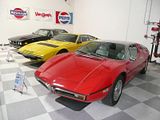
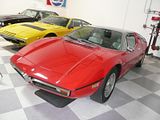 There were a couple of Merak to see, one undergoing some restoration work, the other in fine form. These cars date from 1973 and 1974
There were a couple of Merak to see, one undergoing some restoration work, the other in fine form. These cars date from 1973 and 1974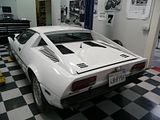
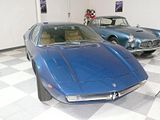 The Khamsin: a 1975 GT, the token rear seats in this would be a total impossibility for anyone with legs of any description, but when the car looks this good, who cares?
The Khamsin: a 1975 GT, the token rear seats in this would be a total impossibility for anyone with legs of any description, but when the car looks this good, who cares?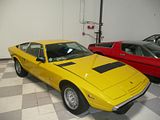
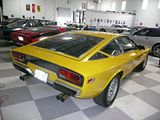
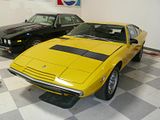 The Kyalami: named after the South African race track, this car was based on the de Tomaso Longchamp, but shares surprisingly few of its parts – just the central section of the body work. I was also surprised to learn how few of them were made – less than 200.
The Kyalami: named after the South African race track, this car was based on the de Tomaso Longchamp, but shares surprisingly few of its parts – just the central section of the body work. I was also surprised to learn how few of them were made – less than 200.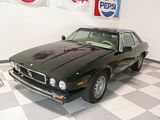 The Biturbo
The Biturbo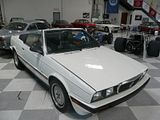 The 3200 GT
The 3200 GT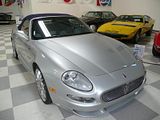
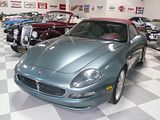
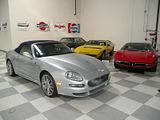 The MC12
The MC12
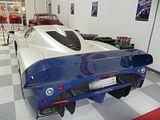
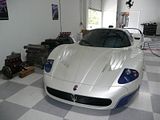
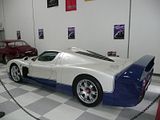 There are a handful of other cars, too:
There are a handful of other cars, too:Jaguar XJ220
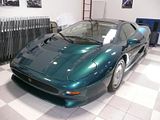 Vector: I’ve never seen one of these apart from in pictures. It turns out that these American built cars, using a Lamborghini engine were deemed to be too similar to the sort of design that Lamborghini was planning for the Diablo, and so they bought out the company, and effectively killed it in the process. Only a small handful of cars were ever made.
Vector: I’ve never seen one of these apart from in pictures. It turns out that these American built cars, using a Lamborghini engine were deemed to be too similar to the sort of design that Lamborghini was planning for the Diablo, and so they bought out the company, and effectively killed it in the process. Only a small handful of cars were ever made.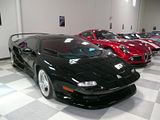

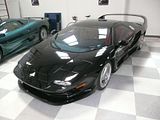 Ferrari 308 and BB512
Ferrari 308 and BB512
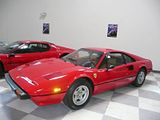 Not one, but two of the recent Ford GT cars
Not one, but two of the recent Ford GT cars
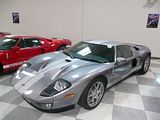
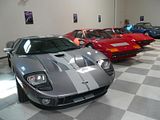
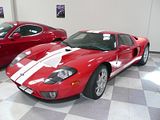 Jaguar “E” Type Series 3
Jaguar “E” Type Series 3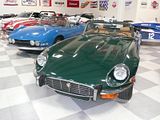
 Riley RME
Riley RME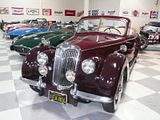
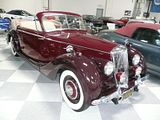 I was somewhat surprised to find this Alfa-Romeo 8C Competizione – and even more so to find that the other guide had to explain to the other couple who visited while I was there just what it was, and that Alfa has a famous sporting pedigree!
I was somewhat surprised to find this Alfa-Romeo 8C Competizione – and even more so to find that the other guide had to explain to the other couple who visited while I was there just what it was, and that Alfa has a famous sporting pedigree!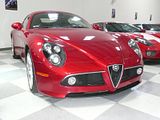
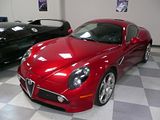
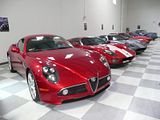 And finally, one of my very favourite cars, a gorgeous Fiat Dino Spider.
And finally, one of my very favourite cars, a gorgeous Fiat Dino Spider.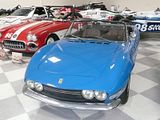
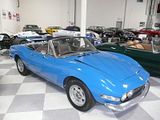
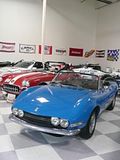
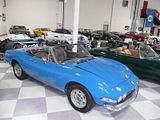 If you are in the area, it is worth a visit. The museum is only open Wednesday to Saturday. More details on their website: http://www.riversideinternational.org
If you are in the area, it is worth a visit. The museum is only open Wednesday to Saturday. More details on their website: http://www.riversideinternational.org2009-09-18 06:50:47


















































































